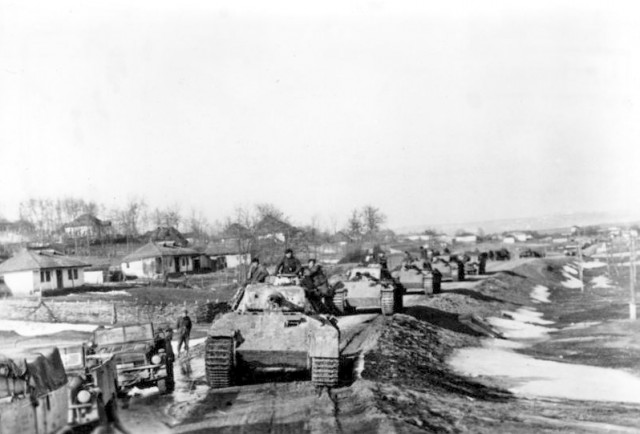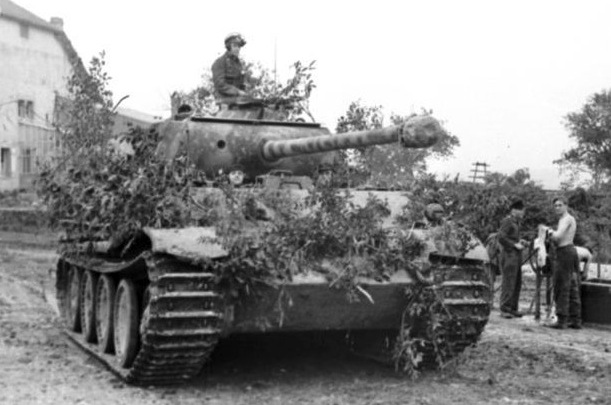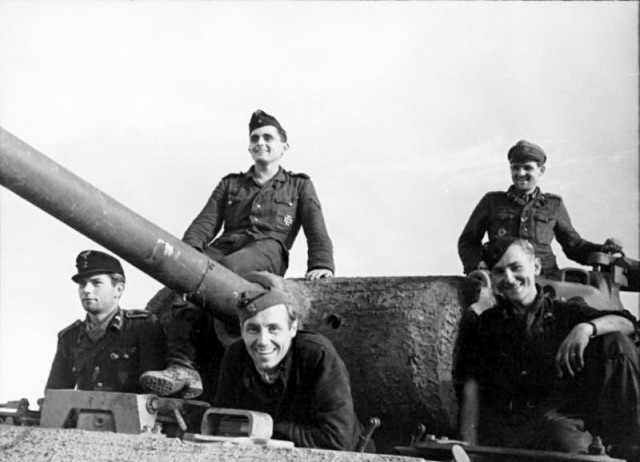 Zentralbild, II. Weltkrieg 19139-45 Der von der faschistischen deutschen Wehrmacht während des Krieges entwickelte neue Panzerkampfwagen Typ “Panther”. UBz: die Verladung neuer “Panther”-Panzerkampfwagen zum Transport an die Front (1943).
Zentralbild, II. Weltkrieg 19139-45 Der von der faschistischen deutschen Wehrmacht während des Krieges entwickelte neue Panzerkampfwagen Typ “Panther”. UBz: die Verladung neuer “Panther”-Panzerkampfwagen zum Transport an die Front (1943).
The German Panther tank was deployed during the Second World War in the European Theater, between the years 1943 and 1945. It saw action on both the Eastern and Western fronts, and is widely hailed as one of the best tanks designed and produced during the conflict.
The Panther was the third most-produced German armored fighting vehicle, after the Sturmgeschütz III assault gun/tank destroyer at 9,408 units, and the Panzer IV tank at 8,298 units.
They proved to be extremely popular, and as a result more than 6000 Panthers were built for the German military. More surprisingly, however, is the fact that nine of these tanks were built by the British Army between 1945 and 1946. This alone is a testament to the high quality of these remarkable war machines.
There were three main version of the Panther – versions D, A and G – with each new version incorporating significant improvements. There were also the artillery spotter, recovery, and Commander versions.
The full name was the Panzerkampfwagen V Panther and it had the ordnance inventory designation of Sd.Kfz. 171. However, on 27 February 1944, Hitler ordered that the Roman numeral “V” be deleted from the designation.
This wan’t the only way in which Hitler was directly involved with the tank’s design. The Panther was originally meant to weigh 30 tons, but the Nazi Leader demanded extra armor and a heavier gun and so it ended up weighing almost 50 tons.

Panther tanks of the Großdeutschland Division advance in the area of Iaşi, Romania in 1944 .Bundesarchiv – CC BY-SA 2.0
Hitler later ordered a Panther II which would feature more armor while still maintaining the same gun, one prototype of which prototype was captured by the Americans. The project was quietly cancelled in mid-1943.
Although weighing a great deal, they could still move at a considerable pace. The later models had a top speed of 46km/h, roughly as fast as the Tiger and slightly faster than the Sherman tank.
These powerful tanks could be used to devastating effect on the battlefield. One of the top German Panther commanders was SS-Oberscharführer Ernst Barkmann of the 2nd SS-Panzer Regiment “Das Reich”. By the end of the war, he had some 80 tank kills claimed.
The Panther tank uses an engine very similar to the one used in the Tiger Tank, with an average life of 1500 hours. The Panther tank came into service after the Tiger tank, the Panther being first used in combat in July 1943 in Kursk whereas the Tiger was first used in Leningrad in December 1942.
More…
456
114
152

Dangerous Signs That You Have TNBC (Take A Look!)
More…
724
181
241
Los Angeles: Watch How Cremation Happens! You Will Be Left Speechless
More…
862
216
287

Panther tank with bush camouflage in Northern France, 1944. Bundesarchiv – CC BY-SA 2.0
Panther tanks were captured on certain occasions and put to use by Germany’s enemies. At least two Panthers were commandeered by the Polish resistance in the early days of the Warshaw uprising, although they were immobilized after several days due to lack of fuel, and were then set on fire.
Russian troops also captured several Panthers, turning them against the Nazis along the Eastern Front. They abandoned them once the tanks broke down, however, as they were deemed too complicated and too difficult to repair.
The Panther had a 7.5 cm main gun that could carry 40 rounds of anti-tank ammo and 39 high explosive shells. It also had two MG 34 machine guns with 5100 rounds of ammunition. The tank needed a crew of at least five men, including a commander, driver, gunner, loader, radioman and machine gunner.

A Panther crew. Bundesarchiv – CC BY-SA 2.0
The Panthers saw a great deal of action during their years in service. At their peak in September 1944 there were 552 Panthers operational on the Eastern Front, out of a total of 728. Later, during the Battle of the Bulge, the Germans used 400 Panther Tanks, five of which were disguised to look like American M10 Tank Destroyers. They did this by welding on additional plates and applying US-style camouflage paint and markings.
There are thought to be five surviving Panthers in running order, two of which were built by the British Army. There are a lot more non-runner Panthers out there in museums, as monuments or in the hands of private collectors.
The last operational report dated March 15, 1945, lists 361 operational out of 740 Panther tanks.





